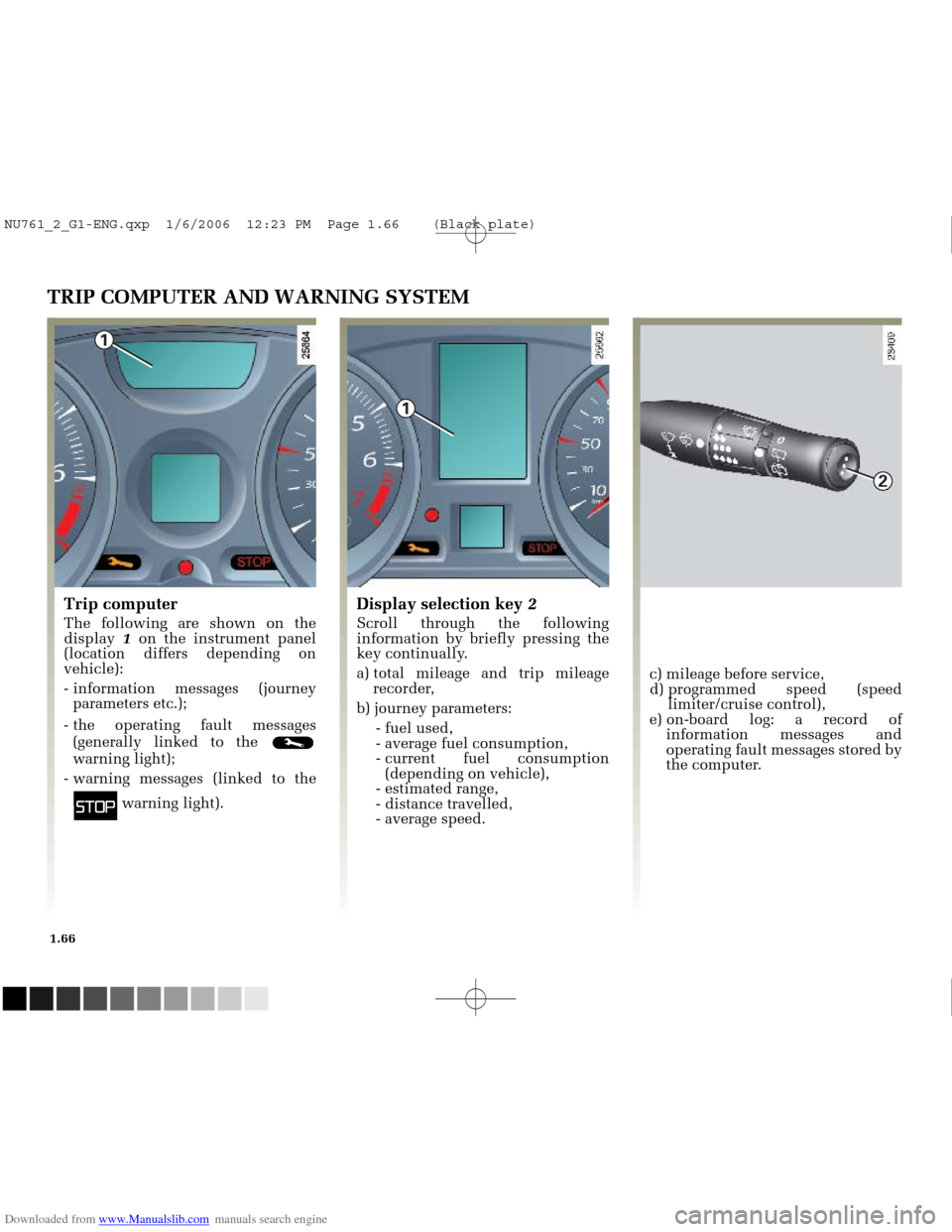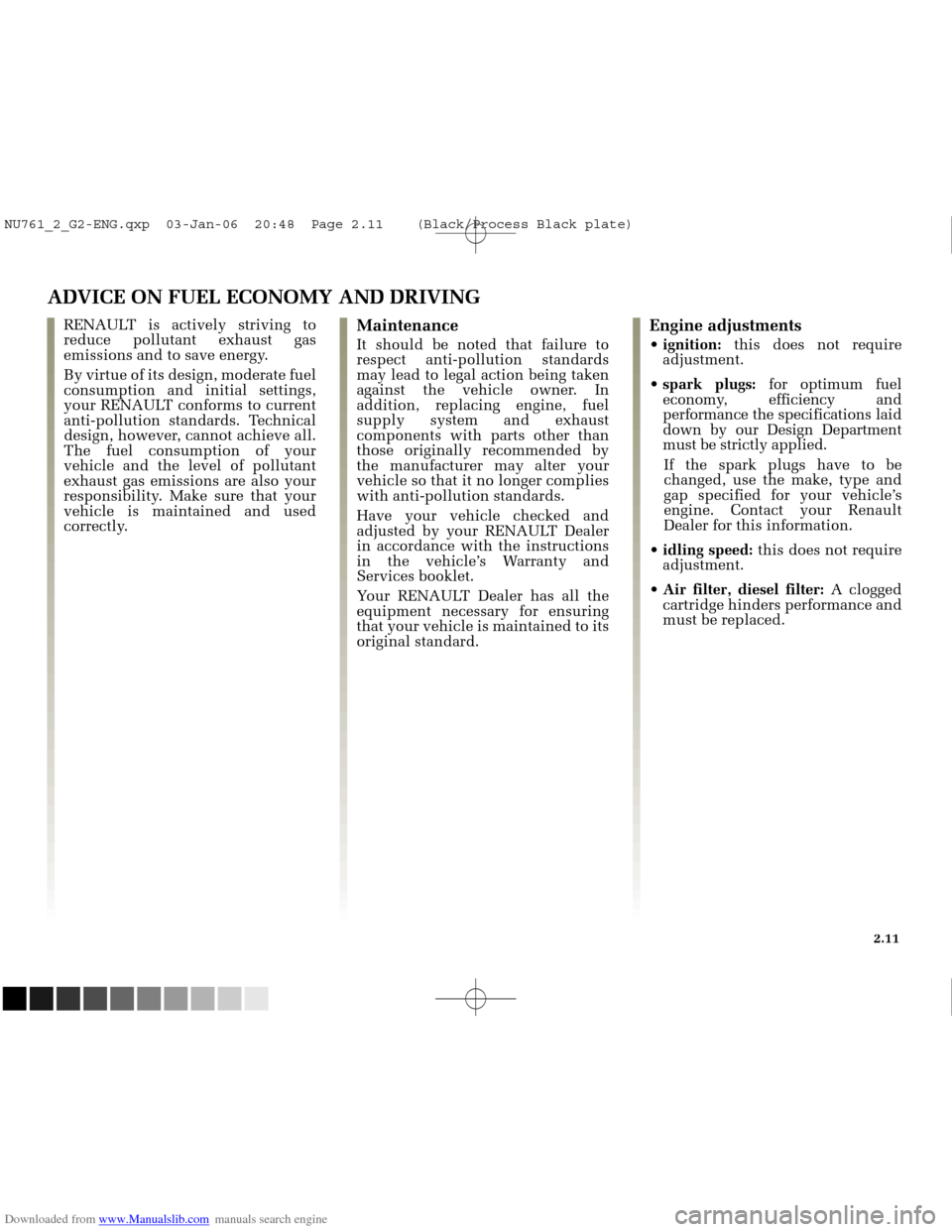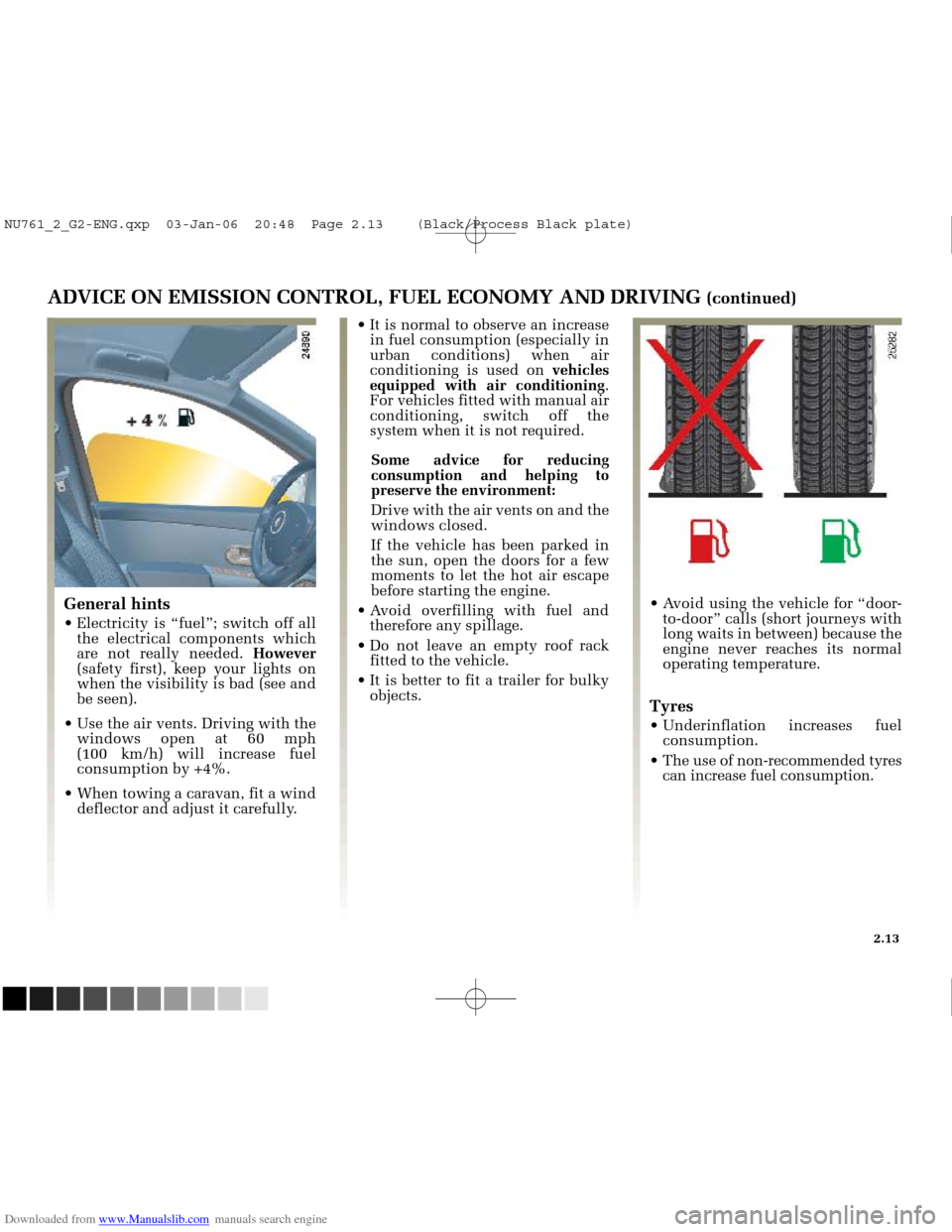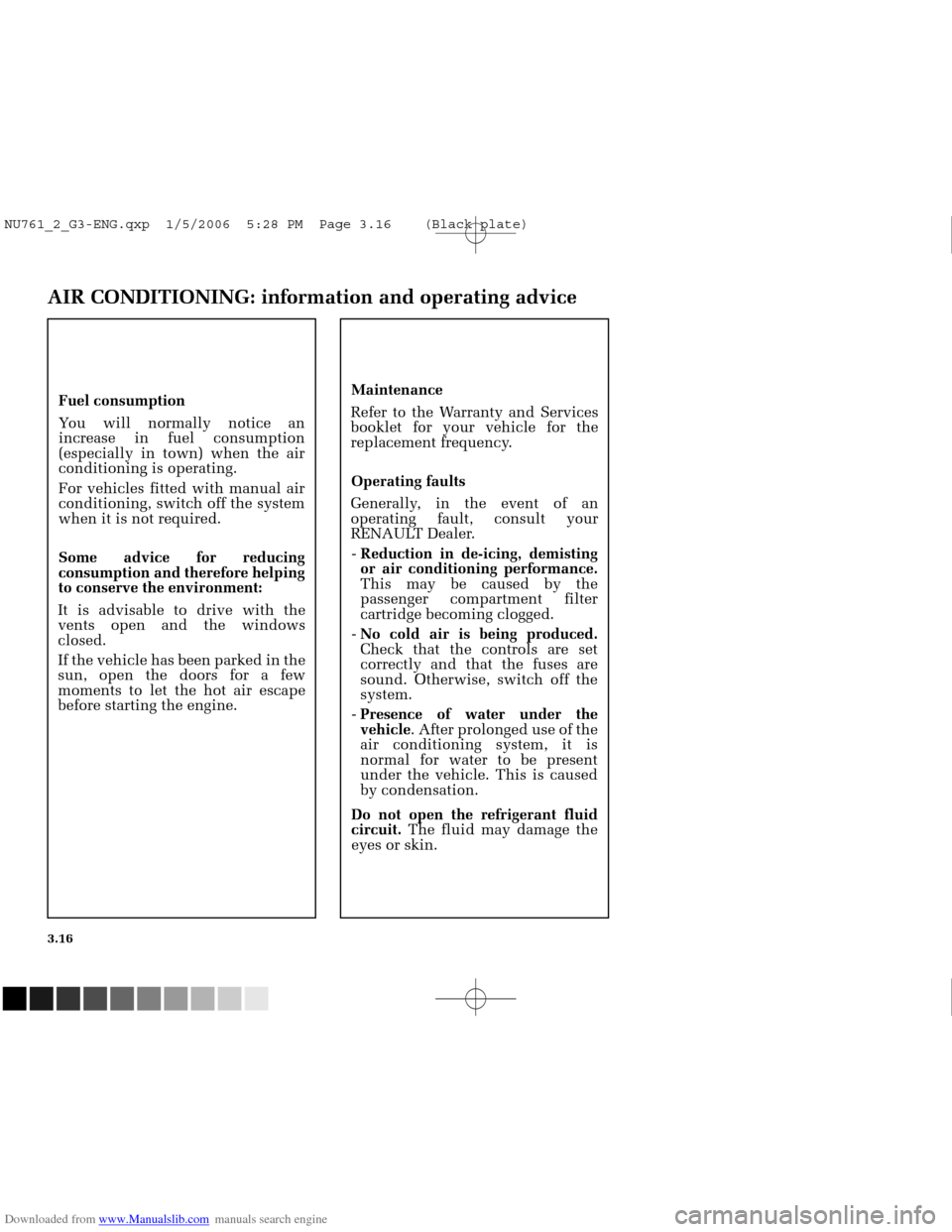Page 76 of 250

Downloaded from www.Manualslib.com manuals search engine
1
2
1
NU761_2_G1-FRA.qxd 10/11/05 15:54 Page 1.66
1.66
TRIP COMPUTER AND WARNING SYSTEM
Trip computer
The following are shown on the
display 1on the instrument panel
(location differs depending on
vehicle):
- information messages (journey parameters etc.);
- the operating fault messages (generally linked to the
warning light);
- warning messages (linked to the
ûwarning light).
c) mileage before service,
d) programmed speed (speed limiter/cruise control),
e) on-board log: a record of information messages and
operating fault messages stored by
the computer.
Display selection key 2
Scroll through the following
information by briefly pressing the
key continually.
a) total mileage and trip mileage
recorder,
b) journey parameters: - fuel used,
- average fuel consumption,
- current fuel consumption(depending on vehicle),
- estimated range,
- distance travelled,
- average speed.
NU761_2_G1-ENG.qxp 1/6/2006 12:23 PM Page 1.66 (Black plate)
Page 77 of 250

Downloaded from www.Manualslib.com manuals search engine
2
NU761_2_G1-FRA.qxd 10/11/05 15:54 Page 1.67
1.67
TRIP COMPUTER AND WARNING SYSTEM (continued)
Trip mileage recorder reset
button
To reset the trip mileage recorder,
select the Trip mileage recorder
display, then press key 2until the
recorder is reset.
Resetting of the journey
parameters
With one of the trip parameters
selected on the display, press
button 2 until the display is reset.
Interpreting some of the values
displayed after resetting
The values showing average fuel
consumption, range and average
speed will become more stable and
reliable the further you travel since
the last time the reset button was
pressed.
For the first few miles after pressing
the reset button you may notice:
that the range increases as you
travel.
This is normal; average fuel
consumption may decrease when:
- the vehicle stops accelerating,
- the engine reaches its operating temperature (engine cold when
reset button pressed),
- when you drive from a built up area on to the open road. that the average fuel consumption
increases when the vehicle is
stationary with the engine idling.
This is normal since the computer
takes account of fuel used during
idling.
Automatic resetting of the
journey parameters
A reset is automatic when the
maximum value for any of the
parameters is exceeded.
NU761_2_G1-ENG.qxp 1/6/2006 12:23 PM Page 1.67 (Black plate)
Page 78 of 250
Downloaded from www.Manualslib.com manuals search engine
23397
23398
23825
NU761_2_G1-FRA.qxd 10/11/05 15:54 Page 1.68
1.68
TRIP COMPUTER AND WARNING SYSTEM (continued)
Examples of selections Interpreting the display selecteda) Total mileage and trip mileage recorder.
b) Trip parametersFuel consumed since the last reset.
Average fuel consumption since the last reset.
This value is displayed after driving 400 metres and takes into account \
the
distance travelled and the fuel used since the last time the reset butto\
n was
pressed.
NU761_2_G1-ENG.qxp 1/6/2006 12:23 PM Page 1.68 (Black plate)
Page 79 of 250
Downloaded from www.Manualslib.com manuals search engine
23939
23402
23527
23826
NU761_2_G1-FRA.qxd 10/11/05 15:54 Page 1.69
1.69
TRIP COMPUTER AND WARNING SYSTEM (continued)
Examples of selections Interpreting the display selectedCurrent fuel consumption(depending on the vehicle)
This value is displayed after a speed of approximately 18 mph (30 km/h)\
is
reached.
Estimated range with remaining fuel
This range takes into account the average fuel consumption since the las\
t time
the reset button was pressed.
The value is displayed after driving 400 metres.
Distance travelled since last reset.
Average speed since the last reset.
The value is displayed after driving 400 metres.
NU761_2_G1-ENG.qxp 1/6/2006 12:23 PM Page 1.69 (Black plate)
Page 111 of 250

Downloaded from www.Manualslib.com manuals search engine
NU761_2_G2-FRA.qxd 4/11/05 10:48 Page 2.11
ADVICE ON FUEL ECONOMY AND DRIVING
Maintenance
It should be noted that failure to
respect anti-pollution standards
may lead to legal action being taken
against the vehicle owner. In
addition, replacing engine, fuel
supply system and exhaust
components with parts other than
those originally recommended by
the manufacturer may alter your
vehicle so that it no longer complies
with anti-pollution standards.
Have your vehicle checked and
adjusted by your RENAULT Dealer
in accordance with the instructions
in the vehicle’s Warranty and
Services booklet.
Your RENAULT Dealer has all the
equipment necessary for ensuring
that your vehicle is maintained to its
original standard.
Engine adjustments
• ignition: this does not require
adjustment.
plugs: for optimum fuel
economy, efficiency and
performance the specifications laid
down by our Design Department
must be strictly applied.
If the spark plugs have to be
changed, use the make, type and
gap specified for your vehicle’s
engine. Contact your Renault
Dealer for this information.
this does not require
adjustment.
A clogged
cartridge hinders performance and
must be replaced.
RENAULT is actively striving to
reduce pollutant exhaust gas
emissions and to save energy.
By virtue of its design, moderate fuel
consumption and initial settings,
your RENAULT conforms to current
anti-pollution standards. Technical
design, however, cannot achieve all.
The fuel consumption of your
vehicle and the level of pollutant
exhaust gas emissions are also your
responsibility. Make sure that your
vehicle is maintained and used
correctly.
2.11
NU761_2_G2-ENG.qxp 03-Jan-06 20:48 Page 2.11 (Black/Process Black\
plate)
Page 113 of 250

Downloaded from www.Manualslib.com manuals search engine
NU761_2_G2-FRA.qxd 4/11/05 10:48 Page 2.13
ADVICE ON EMISSION CONTROL, FUEL ECONOMY AND DRIVING (continued)
in fuel consumption (especially in
urban conditions) when air
conditioning is used on vehicles
equipped with air conditioning .
For vehicles fitted with manual air
conditioning, switch off the
system when it is not required.
Some advice for reducing
consumption and helping to
preserve the environment:
Drive with the air vents on and the
windows closed.
If the vehicle has been parked in
the sun, open the doors for a few
moments to let the hot air escape
before starting the engine.
therefore any spillage.
fitted to the vehicle.
objects.
General hints
the electrical components which
are not really needed. However
(safety first), keep your lights on
when the visibility is bad (see and
be seen).
windows open at 60 mph
(100 km/h) will increase fuel
consumption by +4%.
deflector and adjust it carefully.
to-door” calls (short journeys with
long waits in between) because the
engine never reaches its normal
operating temperature.
Tyres
consumption.
The use of non-recommended tyres can increase fuel consumption.
2.13
NU761_2_G2-ENG.qxp 03-Jan-06 20:48 Page 2.13 (Black/Process Black\
plate)
Page 154 of 250

Downloaded from www.Manualslib.com manuals search engine
NU761_2_G3-FRA.qxd 4/11/05 10:51 Page 3.16
3.16
AIR CONDITIONING: information and operating advice
Fuel consumption
You will normally notice an
increase in fuel consumption
(especially in town) when the air
conditioning is operating.
For vehicles fitted with manual air
conditioning, switch off the system
when it is not required.
Some advice for reducing
consumption and therefore helping
to conserve the environment:
It is advisable to drive with the
vents open and the windows
closed.
If the vehicle has been parked in the
sun, open the doors for a few
moments to let the hot air escape
before starting the engine.Maintenance
Refer to the Warranty and Services
booklet for your vehicle for the
replacement frequency.
Operating faults
Generally, in the event of an
operating fault, consult your
RENAULT Dealer. - Reduction in de-icing, demisting
or air conditioning performance.
This may be caused by the
passenger compartment filter
cartridge becoming clogged.
- No cold air is being produced.
Check that the controls are set
correctly and that the fuses are
sound. Otherwise, switch off the
system.
- Presence of water under the
vehicle . After prolonged use of the
air conditioning system, it is
normal for water to be present
under the vehicle. This is caused
by condensation.
Do not open the refrigerant fluid
circuit. The fluid may damage the
eyes or skin.
NU761_2_G3-ENG.qxp 1/5/2006 5:28 PM Page 3.16 (Black plate)